GCWW History
GCWW History at a Glance
A visual timeline of the History of GCWW – with historic references and more!
GCWW Historic Video Library
Hosted on our GCWW YouTube channel
Former Director of GCWW Returns for Anniversary - Dick Miller Interview
A beloved former director of Greater Cincinnati Water Works recently visited our offices to help commemorate the anniversary of a facility that he was instrumental in getting built, the Frank Harris Sr. Granular Activated Carbon (GAC) facility.
GCWW Celebrates Black History Month!
Bicentennial - H200
In honor of our 200th anniversary in March of 2017, GCWW posted throughout the year information about its unique past on social media. The series was entitled "Splash from the Past" and has been replicated here for your enjoyment.

Quick links:
| Post 1 (3-25-16) |
Post 2 (3-26-16) |
Post 3 (3-28-16) |
Post 4 (3-30-16) |
Post 5 (3-31-16) |
Post 6 (4-7-16) |
Post 7 (4-14-16) |
Post 8 (4-21-16) |
Post 9 (4-28-16) |
Post 10 (5-5-16) |
|---|---|---|---|---|---|---|---|---|---|
| Post 11 (5-23-16) |
Post 12 (6-2-16) |
Post 13 (6-9-16) |
Post 14 (6-23-16) |
Post 15 (7-14-16) |
Post 16 (7-21-16) |
Post 17 (8-11-16) |
Post 18 (8-18-16) |
Post 19 (8-25-16) |
Post 20 (9-1-16) |
| Post 21 (9-8-16) |
Post 22 (9-13-16) |
Post 23 (9-15-16) |
Post 24 (9-22-16) |
Post 25 (9-29-16) |
Post 26 (10-20-16) |
Post 27 (11-3-16) |
Post 28 (11-10-16) |
Post 29 (1-17-16) |
Post 30 (12-1-16) |
| Post 31 (1-15-16) |
Post 32 (1-5-17) |
Post 33 (1-12-17) |
Post 34 (1-19-17) |
Post 35 (2-2-17) |
Post 36 (2-9-17) |
Post 37 (2-16-17) |
Post 38 (2-23-17) |
Go to Historical Posts (Page 2)
Go to Historical Posts (Page 3)
Post 1
"Splash From the Past" Series Begins
We are happy to begin our year-long water history series, "Splash from the Past!" We intend to reach deep into our history, late 1700's, and tell our story until we reach current water practices in Cincinnati. Why? We love our City and the impact water has made on the city for many years. And, well, we LOOOOOVE talking about water almost as much as we LOOOOOVE drinking water!
Please NOTE: we are not historians; these are the highlights and pictures that have been shared with us over the years from prior employees and friends of the utility. By no means are we capturing the entire story as there is so much to tell. We will do our best to provide as much detail and main points as we can. This is intended to be a fun way to share our rich water history as we approach our Bicentennial on March 31, 2017!
Let's begin-
December 1788 is generally conceded as the time the first settlers permanently arrived in the area first known as Losantiville. In 1790, Arthur St. Clair, governor of the Northwest territory, renamed it Cincinnati in honor of the Society of the Cincinnati. The name came from Cincinnatus, a Roman war hero.
Where did they get their water? John Robert Shaw dug the first well in Cincinnati in 1791 at Fort Washington (shown). Prior to this time the residents obtained their water from springs or directly from the Ohio River!
Post 2
1790's
In the 1790’s, the sources of water supply were still springs on private property or shallow dug wells, from which the consumer drew his water supply into a bucket or barrel and carried or hauled it to his home.
To help transport water, William McCash constructed a water cart. This cart was made with 2 poles or shafts with a crosspiece between them and pegs to hold a barrel to carry water. He then constructed another cart with a pair of wooden wheels, 2 ½ feet in diameter- the first wheeled barrel hauled through the streets of Cincinnati carried water!
However, many people got their water from the pump at Yeatman’s Tavern. As announced by Griffin Yeatman (picture) in The Western Spy in 1799: “Observe this notice. I have experienced the many expenses attending my pump, and any Family wishing to receive the benefits thereof for the future, may get the same by sending me twenty-five cents each Monday morning.”
Others sought different options to obtain water and some were charged four dollars per year for the water privilege, the consumer being required to furnish the power to turn the windlass and raise the water from the well!
Wherever you obtained your water during the 1790’s, each household was required to own a wooden or leather bucket to help carry water whenever they heard the cry of “fire”.
Charging for water and transporting it, this was the first evidence of a primitive “Water Works” in Cincinnati!
Post 3
Late 1790's to the early 1800's
Cincinnati residents continued drinking spring and well water, but most gathered their water from the river.
From Daniel Drake's, 'Notices Concerning Cincinnati' - "Well water is generally drunk in the summer, and used otherwise by a few throughout the year. But the water of the river, drawn up in barrels, is employed for all domestic purposes by far the greatest number, and is drunk throughout half the year by at least half the inhabitants."
In the early 1800's, river water had become the dominant source of water in Cincinnati.
Continue to follow our water history series as a major milestone will be revealed soon!
Post 4
Early 1800's
It’s the early 1800’s, and spring, well and river water are available in Cincinnati but not the best water solutions. In 1815, Daniel Drake recaps the state of water in his Natural & Statistical View or Picture of Cincinnati & the Miami Country:
“The water supply was not very efficient. There were a few indifferent springs on the borders of the town plat and a number of wells of various depths. The water from some of these was impregnated with iron. Cisterns were common and afforded good water. A large proportion though of the water was drawn in barrels from the river which being impure required time to settle but was preferable to well water. The proprietors of the steam mill contemplated distributing water from the river over the whole town-a plan so interesting, that its execution will constitute an important era in our public improvements.’”
What's happening here? Our water forefathers were putting plans in motion for a public water supply system!
Post 5
March 31, 1817
The Cincinnati Manufacturing Company was granted exclusive rights to build a public water supply for the Town of Cincinnati for a term of 99 years and a payment of $100 per year. Greater Cincinnati Water Works is 199 years old today!
Continue to watch as our history series unfolds and we approach our Bicentennial!
Post 6
July 3, 1821
First water delivered to the City by the Cincinnati Manufacturing Company. The original water works was constructed entirely of wood, including the pumps, gears, pump lines and a reservoir. There were even two stages of the pumps. The first stage was located on Front Street. It delivered water from the Ohio River to a tank on the north side of Front Street where similar pumps of the second stage took water from this tank and delivered it to a reservoir on Third Street. The pumps were operated by horses or oxen walking on a circular treadmill. The pipes consisted of logs ten inches in diameter, twelve feet in length, with a two-and- a-half inch hole going through them. Note the first fire plug was also put in service with the reservoir. The photo shows the 2 stages of the pumps to carry water up to the wooden reservoir.
Post 7
Wood Mains
Last week we shared that the first water mains in the 1800’s were made of wood. The water mains consisted of logs ten inches in diameter, twelve feet in length, with a two-and- a-half inch hole going through them. Wow, just imagine-a wooden water main! Are you asking yourself, ‘what does it look like’? Since we love documentation and photos, yes, we have pictures to share! AND, We have a section of an old wooden water main in our museum at the Richard Miller Treatment Plant. Check out the photos!
1820’s
By now the Cincinnati Manufacturing Company had met many challenges with providing the finances to carry out the large undertaking of constructing the water works. So the company transferred all of their interests and rights to Samuel W. Davies on March 17, 1820.
From 1821-1825, Mr. Davies struggled with extending the water works and was unable to provide the water pipes as the people desired or the pen-stocks (fire hydrants) necessary in the area. At some point, with financial and operational struggles, Mr. Davies was obliged to ‘stop off the water’ during the night! The citizens were not happy with all of this and even questioned the purity of the water, however, a separate committee found the water to be pure, clear and wholesome.
With various trouble with the water works, particularly challenges with meeting the charter agreement, Mr. Davies was ‘anxious to relieve himself of this burden’ and offered to sell the works to the city for $30,000. Citizens took a vote and decided against it; 294 against, 25 for it. Challenges with meeting the needs of the customers and expanding operations continued for the early years of the water utility.
Post 9
1820’s - 1830’s
Having received interests and rights for operating the water system from the Cincinnati Manufacturing Company, Mr. Samuel W. Davies continues to operate the Cincinnati Water Company. Unfortunately, fire destroys a large portion of the water plant and the City is without water for three weeks as explained in the Charleston Courier, January 11, 1832:
Fire at Cincinnati.--on the night of the 26th, a fire broke out in a large building belonging to the Cincinnati Water company, situated on the bank of the river, and which contained their engine and pumps, for raising water. Before it could be got under, the combustible parts of the building and contents were nearly consumed. The engine, it is supposed, has been injured. There had been no fire used in the building for some hours previously, and it was not known in what manner to account for the accident. [The city was without water for three weeks due to this fire.] Shown is a picture of a fire drum that were often filled with water to transport to fight fires.
Post 10
1832
As shared in our last history lesson, a fire occurred, damaging equipment at the Cincinnati Water Company. As the company was rebuilding, Council appointed a committee to investigate the purchase of the Water Works by the City. The report was favorable toward City ownership with a recommended price of $150,000. The proposal was put to vote and was defeated 617 to 303 on March 10, 1832.
The Water Company continued to struggle with the operation and needed to expand the Water Works. On April 1, 1836, another proposal for the City to purchase the Water Works; this time for $273,670. This proposal was defeated by a vote of 1274 to 956.
The Water Company still struggled with operations as well as the inability to increase the shares of common stock. Citizens didn’t like how the Water Company now had to operate. Some also felt that the City had unintentionally given up powers that should be possessed solely by the City. The ownership issue was put to a vote again, and on the 4th Tuesday in October 1838, the purchase of the Works by the City for a price of $300,000 was put to a vote. It passed by a vote of 1573 to 521!!!!!! But one more vote was needed. March 16, 1839, the State Legislature passed a new act authorizing the City to borrow $300,000 at an interest rate of 6% for the purchase of the Water Works. The vote: 728 to 553; it passed!!!!!
The City immediately proceeded, and on June 25, 1839, the City took possession of the Water Works. The population during this time was around 46,000 people. The Cincinnati Water Works was the first municipally-owned Water Works in the State of Ohio!!!!
Post 11
How have we changed since 1839? We certainly have grown!
Post 12
1839
By now, the City has purchased the Water Works. The officers of the Cincinnati Water Company were retained to operate the utility until September 15, 1839. At a meeting on September 7, 1839, a standing committee of City Council selected a Board of Directors to operate the utility. Edward Woodruff was elected President of the Board; Samuel Davis was appointed as Superintendent and Engineer. Day-to-day operations of the utility would be guided by Samuel Davis.
Post 13
1840’s to 1850
Immediately upon ownership of the water utility by the City, the use of wood pipe ceased. The leakage and resultant damage claims were the obvious reason. At the time, the City still had about 20 miles of wooden water main in service. The last wooden water mains were removed in 1850.
Other early changes to operation dealt with power as there was a great need to increase water supply. The design and construction of “No. 3 Power” was underway. Power #1, “VESTA”, installed in 1824 was retired at this time due to a poor state of repair. Water Works was relying solely on Power #2, “BETSY” installed in 1832. BETSY was a steam driven, duplex non-condensing plunger pump designed by George Shield. It had a capacity rating of 5,000,000 gallons per day. Power #3 was designed at this time with a planned construction cost of $75,000.
Photo: Design of Power #3.
Post 14
1840's to 1850's
Even as early as the 1840’s, Water Works was looking for innovative ways to save costs and an Engineer to move the utility forward.
The City of Cincinnati began to plan and take shape as the city we know today. The population was 46, 338. At this time State Legislature passed a law making certain city officials elected people to positions. Among them was Engineer of Water Works. H. L. Tatem became the first Engineer of Water Works.
In 1845, by ordinance of Council, the position of Engineer becomes an appointed position. in 1846, T. R. Scowden is appointed Engineer of Water Works replacing the only ever elected Engineer at Water Works.
T. R. Scowden was an engineer and inventor, inventing the first revolving, breech loading firearm.
October 5, 1849, T. R. Scowden submitted a proposal for a new reservoir. The reservoir was to be constructed on the south side of Third Street and would have a capacity of 5,500,000 gallons. The reservoir would be constructed of limestone and would replace the 2 older wood reservoirs which had deteriorated to a point that they were considered unsafe. The first part of the reservoir was constructed and placed into service in Dec. 1850; the second part in Sept. 1853. This became the only reservoir in the City until 1875 and would remain in service until 1907. The population in 1870 was 216,239 and 363,591 in 1910.
During the late 1840s and early 1850s, the City of Cincinnati commissioned Scowden to 'make the tour of England and France for the purpose of examining the principles and workings of public docks, sewerage, paving and water-works'. He returned, made his report and promptly resigned! What did he do next? Moved to Cleveland (yes, Cleveland!), our rival even back then, and constructed their water works. He later worked to construct the Louisville, KY water works.
Unbelievable, left us for Cleveland, LOL!
Post 15
1853
The City of Cincinnati continues to grow during this time and more water is needed. 1853 was the first time the Board directed its attention to examination of the water supply and its contaminants. Professor Locke was assigned the responsibility of examining the quality of the Ohio River at the site of the pump station. One of the most comprehensive analytic reports on water pollution that had been made up to that time was submitted. Professor Locke also examined the property near the reservoir as to its effect on the water supply.
By today’s standards, the results would be cause for great alarm, but the conclusion at the time was one of relief. At this time, there was a lack of standards and guidelines in the water industry. As shared by some past GCWW employees, “the seed of concern over water quality had now been sown but it would take over 40 years for it to bear fruit in the form of ‘water treatment’”.
The solution at the time to improve water quality? Passing an ordinance prohibiting swimming of hogs across the river and personal bathing within 500 feet of the water intakes!
That type of hogwash won't do it (Ha, Ha, Ha)!
We have realized over the years, it takes way more than that to produce, safe, high-quality drinking water!
Pictured: Professor Locke
Thanks Central Ohio History, Ohio History Connection.
Post 16
1854
After 22 years of service, Power #2 or “Old Betsy” retires (1832 – 1854). In 1854, a contract was awarded for power #5, which is a duplicate of power #4.
With a growing population came a growing demand for water. In February of 1860, City Council passed an ordinance assessing a tax of ten cents per front foot on all property abutting streets in which water mains were laid. The ordinance was prepared by the City Solicitor, Rutherford B. Hayes, who later became the 19th president of the United States of America.
Post 16 (b)
1866
In 1866, the property for the Eden Park Reservoir is acquired. It is to consist of two basins with a total capacity of 100,000,000 gallons.
The site selected was a deep and rapidly descending ravine, bounded on three sides by steep hills and embracing about 13 acres. A large retaining wall was built and a fill of 84 ft. in depth was made at the southwestern end. The wall itself is a splendid structure with 8 elliptical arches and Dayton Stone trimmings and presents a bold and imposing appearance.
Post 17
1860's
In 1861, a contract in the amount of $200,000 was awarded to the Nile’s Works Company for fabrication and erection of Power #6. George Shield designed this unit. It was the largest unit weighing 900 tons and having a capacity of 12,000,000 gallons per day, expandable to 20,000,000 gallons per day. In 1865, Power #6 was placed into service.
City council also appointed a committee to report on the purity of the water. The report recommended that the water be filtered. Mr. J.P. Kirkwood studied the City’s water quality and recommended moving the City’s water intake several miles upstream and installing filtration.
Post 18
The early days of mixed drinks and happy hours (days in this case)!
1871 - The Henry Clay distillery catches fire and whiskey spills out into the Ohio River. Currents bring the whiskey to the water intakes and for several days the Cincinnati residents enjoyed their water diluted with whiskey! A 'spirited spill' is not a bad deal!
Post 19
1869 - 1875
By this time period, GCWW recognized the need for expansion due to the rapid population growth in the city.
September 1, 1869 - The first “Auxiliary Works” was placed into service (Hunt Street Station). This pumps water from the downtown service to two 750,000 gallon, steel water storage tanks constructed on Auburn Street. The first Power (high pressure engine) has a capacity of 1,500,000 gallons per day.
1871 – The third water storage tank is added on Auburn Street.
1872 – Water Works purchases 146 acres of land known as Markley Farm.
1872 – Extensive testing of the Powers at Front Street reveals the total capacity to be 25,000,000 gallons per day. This is determined to be inadequate, therefore construction begins on Powers #7 & #8 designed by T.R. Scowden.
1875 – The Eden Park Reservoir is placed into service. This brings the total capacity of the reservoir to 100,000,000 gallons.
The photos feature: Front Street Station; the building of Hunt Street Station; the Mt. Auburn Tanks; and an illustration of Markley Farm.
Post 20
Early 1890's
With science and technology improving, many scientific reports are showing a relationship between water-borne diseases and public health. In response, Water Works prepares for the new technologies and plans for the new era of water quality with “Filtration."
1890 – An additional 17,000,000 gallons per day pumping capacity is added to Front Street. Six pumps are mounted on incline cars so they can be moved up and down with the changing river levels.
1892 & 1893 – All pumping machinery at Front Street is rebuilt. This is the last significant work completed at the Front Street Station.
1893 – The original Price Hill Pump Station is replaced by a new station located at 6th Street & Mt. Hope Avenue.
1894 – The Eden Park pumping station and water tower are placed into service. The old Mt. Auburn tanks are removed and replaced with taller vessels.
The photos feature: workers at the Price Hill Pump Station; the Price Hill Pump Station; and the new Mt. Auburn tank.
Post 21
Major decisions made for the City water utility
December 21, 1895 - As Cincinnati’s population of 307,500 booms, water consumption grows to a daily average of more than 47-million gallons. In response, the Board of Administration adopts a resolution to employ a Commission of Engineers that will investigate and provide a report proposing possible improvements to the water system.
March 20, 1896 - Within only a few months, the Commission of Engineers submits a report to the Board accompanied by plans and an estimate of cost. The report recommends that high- and low-service pumping stations, settling reservoirs, sand filters, and distributing reservoirs be constructed near the Village of California, with a gravity pipe line to the Eden Park Reservoirs. The report was presented to the Hamilton County delegation of the 72nd General Assembly of Ohio.
April 24, 1896 – The General Assembly of Ohio passes the “Water Works Act” enabling the City to sell bonds and construct water facilities. As a result, Ohio Governor Bushnell appoints a five-member Board of Trustees to be commissioners of the Water Works.
In early 1897, the Ohio Supreme Court affirms legality of the Water Works Act and the City is able to proceed with the plans. This greatly expands the City’s ability to fund construction and provide the recommended improvements to the water supply system. Because of these improvement and advances Cincinnati becomes known as one of the "Cities of the First Grade of the First Class.”
The photo features a pump at the Linwood Pump Station during this time period (1895).
Post 22
Special Conference Edition
The year of the American Water Works Association’s (AWWA) birth was 1881. On March 29 in Engineers’ Hall on the campus of Washington University in St. Louis, Mo., 22 men representing water utilities in Illinois, Indiana, Iowa, Kansas, Kentucky, and Tennessee founded the American Water Works Association. They adopted a constitution that stated the purpose of the association as being “for the exchange of information pertaining to the management of water-works, for the mutual advancement of consumers and water companies, and for the purpose of securing economy and uniformity in the operations of water-works.” That first meeting covered topics ranging from the “poisoning” of water by lead pipes to the efficacy of using corncobs for fuel.
From 1900 to 1913, the portion of the US population that was served with filtered water increased eightfold, and the typhoid death rate plummeted by 55%. In 1914, the US Public Health Service adopted the first microbiological standards for drinking water to implement the Interstate Quarantine Act. AWWA urged its members to comply with the standard even though it only applied to water served aboard trains and vessels that crossed state lines.
The association continued to provide leadership, champion public health, and publish much-needed information.
The first National AWWA Conference held in Cincinnati was in May of 1915. At this Conference, the Central States Section of the AWWA was approved by the Board of Directors. (This was the 4th recognized by AWWA). Ohio was one of the member states within this new Section and participated until 1938, when Ohio became a stand-alone Section. This week, Cincinnati will host the 78th Ohio Section American Water Works Association conference.
Post 23
1872
In honor of Cincinnati's Oktoberfest Weekend, GCWW celebrates its German-based history today:
By 1872, thousands of German immigrants made new homes in Cincinnati after the German States Revolutions of 1848 - 1849. This heavy influence of Germans living in Cincinnati prompted the Cincinnati Water Works to publish the annual report in German.
Fun Water Fact: Did you know it takes 20 gallons of water to make 1 pint of beer? (You also can't make sauerkraut, goetta, bratwurst or schnitzel without using water!)
This weekend, try asking, "Könnte ich ein Glas Leitungswasser haben?"and see what happens (enjoy a glass of GCWW water!)
Post 24
1897
On December 3, 1897, George Warren Fuller was appointed by the Engineer Corps to conduct sedimentation and filtration studies to be used in the new treatment plant, and was the Chief Chemist and Bacteriologist for these studies. Fuller was also president of both the American Water Works Association and the American Public Health Association; and he was recognized internationally as an expert civil and sanitary engineer.
In March of 1898, an experimental station was placed in full operation near the Eden Park Reservoirs. George Warren Fuller conducted a series of tests through January 1899, which served as the design basis for the full-scale “Rapid Sand Filtration System” (or “American System”) that was later implemented in the New Works Water Treatment Plant and at many other facilities across the nation.
As Abel Wolman wrote in an editorial in Municipal Sanitation after Fuller's death on June 15, 1934:
"... Heredity and environmental influence, coupled with remarkable energy, all contributed to the development of a practitioner of outstanding stature. Mr. Fuller will be remembered long in the future, as much for his distinctive personal characteristics as for his long list of contributions to sanitary science and practice."
Post 25
1897 - 1909
The period of 1897 to 1909 is known as the “New Works” era of the Water Works. During this period, the city built an entirely new Water Works. For the first time in its history, water quality is addressed in the form of a physical plant rather than just presented in studies and reports.
September 11, 1899 – The Water Works is able to cease using the old Linwood Pumping Station and tanks.
1901 – The Intake Pier Bridge and Shore House were placed into service.
The photos feature the Intake Pier and the old Linwood Pumping Station.
Post 26
1890 – 1900
We are now in the late 1890’s and early 1900’s of the water utility construction. The “New Works” takes shape, with the construction of the Main Station.
Originally known as the Western Pumping Station, the Main Station was re-named to better describe its function and design as a primary pumping station for the New Works. Since its main purpose was to deliver water to the city from the treatment facilities that were being built upriver, at the new River Station, the name fit quite nicely! (The name change also eliminated confusion with the Western Hills Station).
Site preparation for the Main Station began in 1900; in 1901, the contract for the pumping machinery design was awarded; and in 1902, the construction contract was awarded -- that's when the work began.
The new pumping units at Main Station were of the triple-expansion, steam-driven, plunger-pump design – the workhorse of the era. This style was required due to the ever-growing capacity and high demand of the region. As a matter of fact, the demand was so high, that a total of six units were to be installed. Three 12,000,000 gallons-per-day units would supply water to the Eastern Hills System; while the other three 20,000,000 gallons-per-day units were to provide water to the Central Service System.
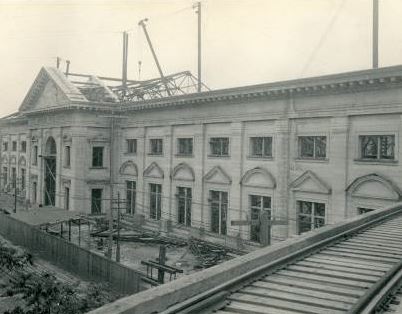 |
|
|---|---|
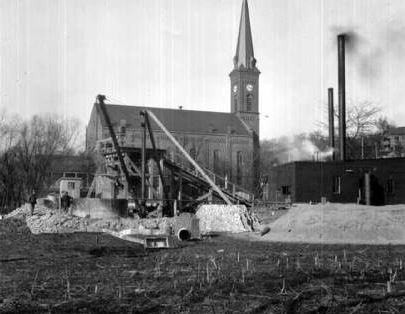 |
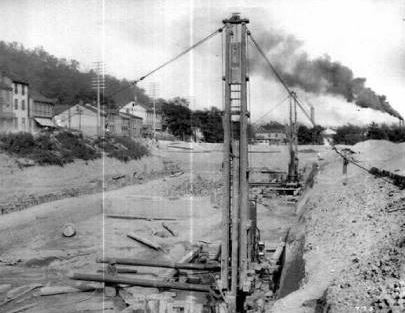 |
Post 27
1906 – 1907
The New Works Water Treatment Plant becomes operational.
Construction of the new treatment plant began in 1898 approximately ten(10) miles upstream from downtown Cincinnati.
This is a unique period in history when four of the world’s largest vertical, triple expansion, crank and flywheel, water-pumping steam engines were incorporated in an equally-unique pump house for the Cincinnati Water Works. Most everything about the design of the engines and the pump house was influenced by the wide range of the Ohio River from pool stage at two-feet deep to above 75 feet at flood stage. Sitting deep in the ground, the pump house was built at ground level and lowered by hand to a depth of 105 feet.
The facility included a circular pump house, boiler room, an auxiliary building, and an elevated coal-storage building, a coal-hoisting house, a de-aerating plant and water-softening plant.
By October 1906 pump engines became available for service:
- October 6, 1906 = Unit 2
- April 28, 1907 = Unit 3
- May 9, 1907 = Unit 1
- August 13, 1907 = Unit 4
On October 22, 1907 continuous filtration began using the new rapid-sand filters. By November 1, 1907 all operations at Front Street ended while the entire water supply for the city was now provided by the new treatment plant.
 |
 |
|---|---|
 |
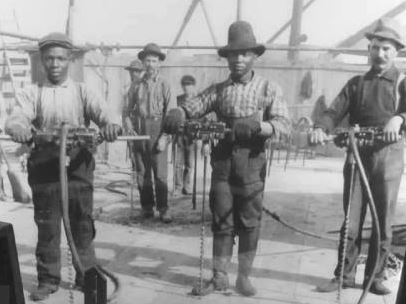 |
Post 28
Western Hills Pump Station – April 15, 1907 - The New Works continues to expand.
The Western Hills Pump Station was placed into service with the installation of two new snow pumping units. This new station provided water to the Price Hill and Fairmount territories, and had a pumping capacity of 7 million-gallons a day. Two air and gas compressor units were moved from the old Linwood Pumping Station and put in service on October 20, 1908. Upon completion of the Western Hills Pump Station, the Mt. Hope and Westwood Pump Stations were no longer necessary and removed from service.
Photos feature the Western Hills steam-powered pumps, the Western Hills Pump Station, and the old Westwood Pump Station.
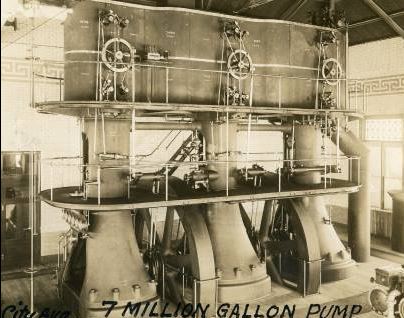 |
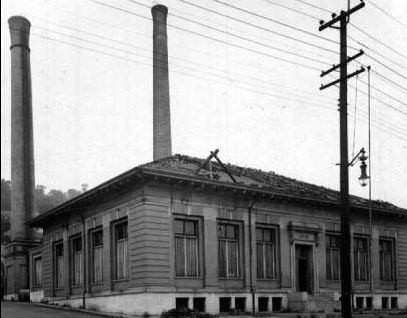 |
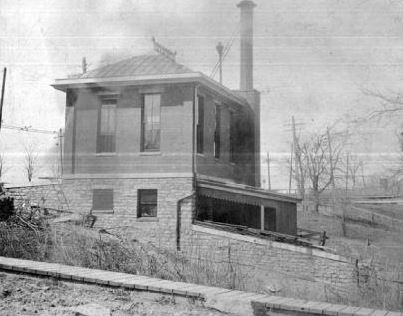 |
|---|
Post 29
1908 - 1910
What was happening at the Water Works from 1908 to 1910?
In 1908, The Cincinnati Health Department notes a significant reduction in typhoid fever in Cincinnati, due to the operation of the new water treatment plant.
As so eloquently stated by Theodore R. Scowden, “It is a cause to which the highest medical authority attributes so many virulent and unmanageable diseases, to which pure water is an antidote, hence, the necessity of establishing Water Works from such influences becomes indispensable….”
By the end of 1908 the entire “New Works” was essentially completed; all of the Old Water Works was abandoned; and Cincinnati Water Works assumed full operational control of the “New Works.” The only significant facility that remained was the Eden Park Reservoir, which to a great extent, still remains in service today.
By July of 1909 the City of Cincinnati had expanded to 50.59 square miles. With production from the newly-built Water Treatment Plant, the city was able to not only supply itself enough water, but also generated a surplus, and chose to sell to areas such as Cheviot, Mt. Healthy, St. Bernard and Elmwood.
The City of Cincinnati assumed most of the operational responsibilities of the “New Works” in February 1909; and the date the “New Works” was turned over to the City of Cincinnati is generally considered to be July 1, 1909. This is not to say that all work had been completed nor were all the contracts closed by this time, (guarantee requirements, results of litigation, performance demonstrations, and other finishing details went well into 1910) but the “New Works” was certainly well on its way.
The photos feature the Main Station, the New River Station, and a Typhoid cases chart.
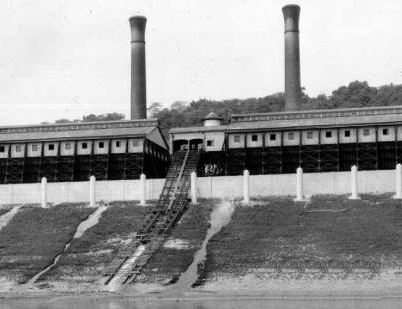 |
 |
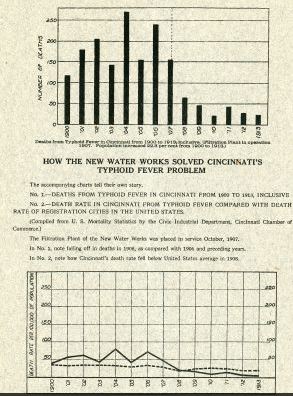 |
|---|
Post 30
1908 - 1911
Safe Drinking Water is a Top Priority
1908 -- Analysis showed that Cincinnati Water was purer and more wholesome than water drawn from any well or cistern within the city limits; and in March of 1908, The Board of Health passed a resolution directing the Health Officer to inspect all the wells and cisterns in the city. If he found any of them polluted or likely to become so, they were to be filled up. This resolution was the beginning of stamping out water diseases in Cincinnati, especially typhoid fever.
1910 -- A large amount of research and experimental work was also under taken and partially completed, including a sanitary investigation of the Ohio River water as it passed the city and the sterilization of the city’s water supply by the use of hypochlorite of calcium and sodium. Chlorine, in the form of a bleaching powder solution, began to be intermittently used for disinfection purposes.
1911 -- An extensive Water Main cleaning project began; to remove years of sedimentation, resulting from pumping untreated river water; and clean, safe water service is extended to the communities of Carthage, College Hill, and Madisonville as a result of annexation.
Post 31
1912
In 1912, the new Ferguson Road water tanks went into service. This effectively retired the tanks located at Considine & Glenway; and the Westwood tank.
On August 14, 1912, the first federal drinking water regulations (concerning microbial contaminants) went into effect with the Public Works Service Act, which only addressed drinking water involved in interstate commerce. These first standards were developed by the Department of Treasury.
Post 32
1915 - 1920
Cincinnati Water Works improved the water distribution and quality.
In 1915, the Price Hill/Fairmount and Westwood Services were permanently combined and placed into service, thus establishing the “Western Hills System.” The Eastern Hill Unit #4 -- a 17,000,000-gallon-per-day pumping unit -- was also placed into routine service.
Beginning in 1915, Cincinnati Water Works (CWW) periodically used chlorine as a disinfectant to reduce suspected waterborne diseases.
By 1918 chlorine had proven to be so successful as a disinfectant, that CWW began to use it regularly. As a result, when combined with filtration, the majority of waterborne diseases were now able to be controlled.
In 1920, CWW battled taste and odor issues by experimenting with the practices of double-coagulation and excess lime dosage. The success of these practices eventually led to the reduced use of chlorine.
The photos feature a chlorinator apparatus and the Western Hills Pumping Station interior.
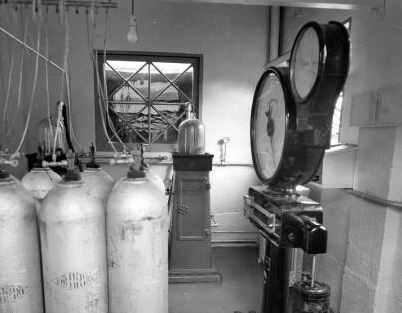 |
 |
|---|
Post 33
1923 – 1926
The mid-1920's:
An early rejuvenation of downtown began in the 1920’s and continued into the next decade with the construction of Union Terminal, the post office, and the large Cincinnati and Suburban Telephone Company Building. Similarly, the Cincinnati Water Works continued to develop and provide water to more residents.
In 1923, the Board of County Commissioners (who established and maintained sewer districts) became linked with the Cincinnati Water Works (CWW) when House Bill No. 23 passed. This collaboration led to CWW taking over the billing and collection of water bills and established a two-year contract with the County to supply water to the area outside of Cincinnati in 1924.
Between 1924 and 1925 the City of Cincinnati adopted the Council/City Manager form of government. Murray Seasongood was elected Mayor, and C.D. Sherrill was appointed as the first City Manager. Also during this period, the Winton Road Reservoir and the Western Hills Pumping Station (an 8,000,000 gallon-per-day pumping unit) were placed into service.
By 1926, the County found that supplying water to their residents was not a process they needed to oversee; and a 20-year contract was negotiated with the Cincinnati Water Works to supply water to county residents.
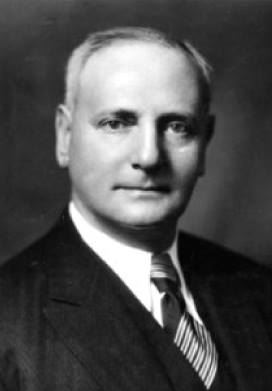 |
|---|
Post 34
1927 – 1929
GCWW continues water quality and distribution improvements:
In 1927, the College Hill Station is removed from operation, and Mt. Airy Tanks go into service.
As you can imagine, by this time the sand filters were filthy, and in 1928, the process of putting fresh sand in all 28 sand filters begins; this project takes two years.
Speaking of cleansing in 1929, the wash water reservoirs and pumps are also placed into service. (The wash water and pumps are used to make the cleaning of the reservoirs more efficient.)
The photos feature the Mt. Airy tanks, workers adding new sand, and a photo of workers in 1929.
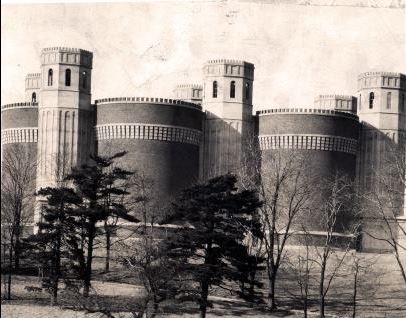 |
|---|
Post 35
More on the Water Quality Front
In the early 1930's, Cincinnati Water Works focused on ways to improve Water Quality. In 1930, after in-house evaluations, the Cincinnati Water Works first used powdered activated carbon in combating taste and odors issues. It proved to be a very beneficial treatment tool. But why was this needed? Due to the low-level dam system, the river was at extremely low levels throughout the summer and fall, and the effects on water quality were noticed. The Fernbank Dam also had a high concentration of sewage products, which impacted the quality in two ways.
The first was the obvious presence of sewage and its by-products. The second and more difficult impact was the clarity of the water and nutrients present which caused unprecedented growth of natural organisms. These organisms imparted undesirable tastes and odors as well as coloration in the water. Double coagulation and chlorine/ammonia application were used to remedy the issue.
In 1931, Cincinnati Water Works began adding ammonia because small amounts of phenol compounds were present in the river due to increased industrialization of the Ohio River Valley. When low levels of chlorine are added to water containing phenol, the chlorine forms compounds that give the water a very bad taste. Adding ammonia before chlorine blocks the chlorine from reacting with the phenol, yet still allows for proper disinfection.
In 1932, a decorative concrete house was built over the valve chamber that housed the 60-inch lines going from the clearwell to the tunnel shaft. A sample pump was also installed which made it possible to obtain water samples leaving the plant with little effort despite weather conditions. The chamber was and is today, referred to as Chamber G.
The photo features an ammoniator apparatus.
Post 36
"FORE!"
In 1933, the City of Cincinnati's Recreation Department opened golf operations on the Cincinnati Water Works properties surrounding the Settling Reservoirs, while the Eastern Hills steam-turbine-driven pumping unit (a 25,000,000-gallon per day pumping capacity) was placed into service at the Main Station.
In 1934, the Greenhills System was created as a part of the Federal Government “Greenbelt” experiment. The Greenbelt was a public cooperative community in the New Deal Era. The federal government attempted to foster a self-sufficient cooperative community that would ease the pressing housing shortage, create jobs, and help stimulate the national economic recovery following the Great Depression.
Post 37
"Choo Choo!!"
In 1935, the Ohio River became available year-round for commercial navigation with the full implementation of the low-level system of locks and dams.
During this time, the railroad became a less-viable commercial venture, and the owner began to sell off the assets. Cincinnati Water Works (CWW) purchased a portion of the Cincinnati Georgetown & Portsmouth Railroad from its junction with the main line and the California Plant. The purchase included the track system, right-of-way, and a steel car-house located on Carrel Street. A 20-ton Whitcomb gasoline-driven locomotive for $7,330 and a gasoline section car for $284.86 were purchased separately from the railroad. This was essentially the same portion of the railroad that was built in preparation for the original construction of the plant. CWW owned and operated their portion of the railroad until 1944, when it was determined that truck shipments of the chemicals and other commodities were less expensive. At that point, the tracks were abandoned, but the connection to the railroad as well as the facilities on Carrel Street remained. (This facility was not completely abandoned until the late 1990’s.)
Post 38
"1935 was a very productive year for the Cincinnati Water Works."
The results and recommendations from Burns & McDonnell consultants were completely evaluated, and the Cincinnati Water Works (CWW) was ready to proceed with the total renovation of its treatment facilities. While a number of recommendations were considered to be feasible, the following improvements were those that made the final list:
- Covering of the clearwell to prevent deterioration of


/1.JPG)





.JPG)
